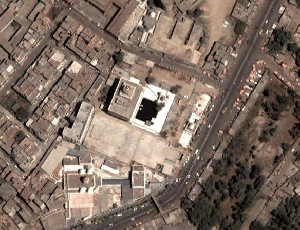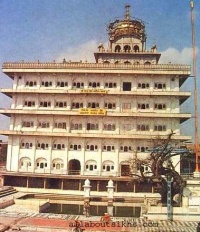Gurdwara Ramsar Sahib
Many sacred Sikh shrines can be found in the Sikh holy city of Amritsar. Of particular importance are the five sacred pool in this city. These are called sarovars and it is the practice of some Sikhs to have a dip in all five of these holy pool. The ritual apart from being good exercise, acquaints one with the importance of these five sites. Among these famous five historical shrines is the Gurdwara, Ramsar. This located south-south-east of the most important landmark for the Sikhs, Harimandir Sahib.
Alongside the Ramsar Gurdwara is situated the smallest of the five Sarovar called Ramsar sarovar. This is the location where in 1603, Guru Arjun Dev, the fifth Sikh Guru spent over a year in semi-seclusion along with his scribe, Bhai Gurdas to compile the holy Adi Granth, the sacred Sikh scripture. The sacred volume was finally completed in 1604 and installed with due honor and ceremonies in the Harmandir Sahib which lies to the north of this location.
Gurdwara Ramsar stands on the north-western bank of the Ramsar sarovar, near Chativind Gate, on the south-eastern side of the walled city. After the completion of the building of the Harimandir Sahib in 1601, Guru Arjan undertook the compilation of Adi Granth, the Holy Book, now revered as Guru Granth Sahib.

For this task, he chose a secluded site. The selected spot was then a shady nook, one km away from the bustle of the town. To make the surroundings more agreeable, he had a small tank dug which was named Ramsar after his father, Guru Ram Das. Here, Guru Arjan composed his famous Sukhmani, the Psalm of Peace, and with Bhai Gurdas as his scribe compiled the Adi Granth during the period 1603-04.
The present Gurdwara Ramsar is a small marble-lined hall topped by a gilded, fluted lotus dome and was built in 1855 at the site of the original shrine and this site marks the site of the Guru's labours and the beginning of the Sikh tradition. This was the place where the current, perpetual and honoured Sikh Guru, Guru Granth Sahib was first created. So, this site is of special significance for the Sikhs.
In this holy book, Guru Arjun Dev collected the hymns of first four Gurus, namely Guru Nanak, Guru Angad, Guru Amar Das, Guru Ram Das and adding his own compositions as well as selections from the writings of several Hindu and Muslim saints. The selection for the holy scripture was based on the main principle of Sikhism. In this unique holy book is preserved the purity of the scriptures, embodying, the philosophy of the Gurus for the perpetual guidance of the Sikhism and other faiths.

